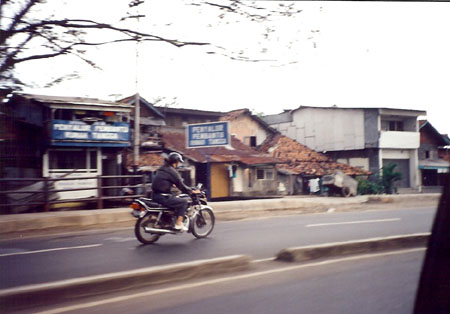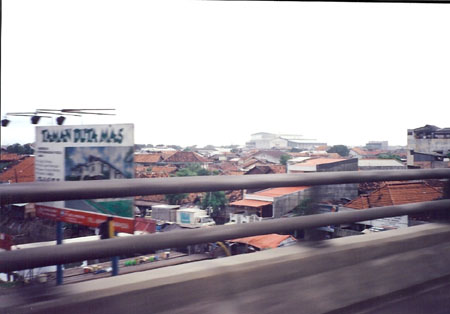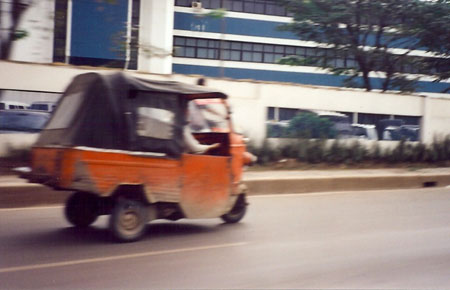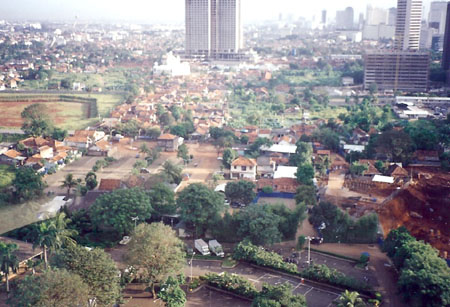Home
Photo Menu by Country
Photo Menu by Subject
Trip Articles
Terms
Edmonton Shrine Motor Corps
Habitat for Humanity Ina's Trips

|
JAKARTA, INDONESIA
March 1993
I arrived shortly after noon and it was hot and humid. As the plane approached the airport it was impossible to see the horizon because of the haze in the air and as we got lower it became more apparent and also took on a brown tinge.
Everything on the ground appears green as there are lots of open fields and trees. The land surrounding Jakarta is quite flat, however, there are mountains in the distance. As the plane gets lower I can see red tile roofs amongst the trees. The trees and the space between the houses looked quite nice from up high but as I got a closer look it was apparent that a lot of the houses were made of tin, thatch or old wood and the whole place looked like a very large, very poor tropical village with shacks, dirt roads but lots of palm trees and other plant growth.
 The airport is quite far out of the city so the drive into Jakarta was through some nice rural areas with rice paddies and other types of farms with a few water buffalo, goats etc. There is lots of water around and some of the larger ponds had people fishing. Quite a lot of the men who should have been working along the highway were under the trees having a sleep. It was shortly after noon and with the heat and humidity sleeping seemed like the smartest thing to be doing. The airport is quite far out of the city so the drive into Jakarta was through some nice rural areas with rice paddies and other types of farms with a few water buffalo, goats etc. There is lots of water around and some of the larger ponds had people fishing. Quite a lot of the men who should have been working along the highway were under the trees having a sleep. It was shortly after noon and with the heat and humidity sleeping seemed like the smartest thing to be doing.
Alex, the company driver, spoke some English which was a nice change although he would only speak when spoken to and answer questions but not carry on a conversation. We passed a couple of golf courses and a number of large and unusual statues along the highway. Satellite dishes appear quite common which is something not seen in Singapore and they point almost straight up.
I saw the following once we were in the city and during trips around Jakarta over the next few days:
 Pajaj (similar to a Took Took in Thailand). All were orange with a black convertible type roof. Have a "Y" shaped frame and are much shorter than a Took Took. Most were in a very beat-up state.
Pajaj (similar to a Took Took in Thailand). All were orange with a black convertible type roof. Have a "Y" shaped frame and are much shorter than a Took Took. Most were in a very beat-up state.- Lots of sidewalk vendors. Some have a small stall while others are just a box on the ground with a few things. A few simply had their goods on the ground.
- Sidewalk vendors sold such things as pop, food, papers, magazines, car hub caps, clothes, watches, and
 in one area there was at least a complete block of vendors selling potted plants and garden supplies. This was one of the nicest blocks in the city because the potted plants hid the shacks. in one area there was at least a complete block of vendors selling potted plants and garden supplies. This was one of the nicest blocks in the city because the potted plants hid the shacks.
- Drivers are very aggressive and use the horn a lot. If the traffic is the least bit busy they seem to be able to create at least one extra lane on the street by ignoring what lines may be there. Lots of cutting off and squeezing into small spaces.
- There were lots of roosters and chickens and an occasional goat within the city.
- I saw a beautiful artificial rock wall with a waterfall, plants and small statues built into it. It was about 10 or 12 feet high with a total length of about 20 feet. It was surprising because it was in a rather poor rundown area. I quickly realized that it was a display as there were a number of them as well as street side vendors who sold the stones etc. to make them. This type of thing would look great in the right garden setting.
- Lots of beggars on the streets. This was the first time I had seen begging so widespread and out in the open. Small children and cripples will congregate in areas where the traffic usually jams up and will walk between the cars looking for handouts. This was most evident during a rain storm when there were a few kids out there dressed in rags and soaked to the skin. It was apparent that they knew how to look as pathetic as possible. One man who was missing an arm just below the shoulder was walking between the cars with an old hat covering the stump and he would come right up to the car window and uncover the stump and stick it toward the window, holding the hat out for money. I didn't notice any, but was told that there are a number of lepers in Jakarta that survive through begging.
- There were also hawkers who would wander up and down the traffic jams selling drinks, news papers, fruit and other small items.
- Between 6:30 and 10:00am certain main roads within or going to the main city area are restricted to cars which must have a minimum of three people. It is called the 3 in 1 rule. As you approach the restricted area there are kids lined up along the side of the road hitch hiking fashion. For a fee of Rp1, 000 - 1,500 (US$.50 - .75) they will ride in the car as the extra person that is required. When you get to where you're going or leave the area, you pay them and they find their own way back.
When talking to our Unit Manager I learned that only a very small area of Jakarta has piped in water and a sewage system. Most homes have their own well, pump and septic system and the kampongs and poorer areas usually have a central well and an open sewer of some type. This setup became much more apparent when I was out in the country. piped in water and a sewage system. Most homes have their own well, pump and septic system and the kampongs and poorer areas usually have a central well and an open sewer of some type. This setup became much more apparent when I was out in the country.
I saw a number of English words that had been adapted into Indonesian usage. Taxi was spelt taksi and a combination meal of several Indonesian foods I had was called Nasi Rames Komplit (complete).
I went by car to Merak which is about 50 miles (a one to two hour drive depending on traffic) west of Jakarta. The rural life and scenes are quite idyllic with lots of rice paddies and several kampongs along the way. Harvesting was in progress in several areas so there were lots of people working in the fields. All of the farming is done manually or by using animals such as water buffalo. Kampongs along the way are enlightening as to the poor living conditions outside the city but the people seem quite content and there are lots of kids around playing games and enjoying themselves.
Saw Krakatoa in the distance as we were in the Merak area. This is a volcano that erupted in 1883 and disintegrated an entire island with the most violent explosion in recorded history. Apparently Anak Krakatoa (Son of Krakatoa) has been showing some activity lately and the fire from the eruptions is sometimes visible from Merak at night.
One evening I took a trip to a local department store that had been recommended as a good place to look for souvenirs. There was an entire floor of arts and craft type articles from all over Indonesia and the range of items was fantastic and certainly reflected the diversity of the Indonesian culture. The items vary greatly in style and design depending on the area or island that they come from.
|

